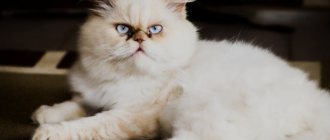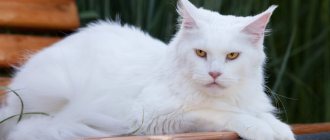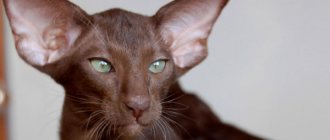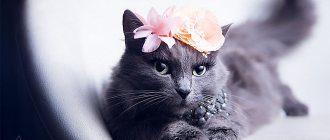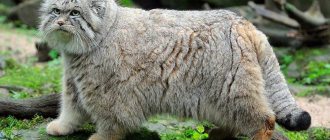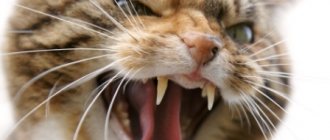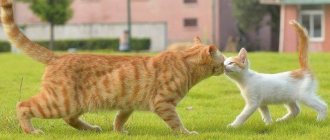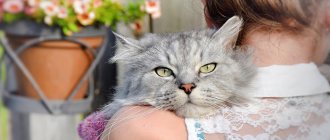There are many stories about incredible mysterious creatures, and those who like to draw in Photoshop are creating more and more animals that have nothing to do with reality. But there is not an ounce of Photoshop in this collection., all these animals really exist. Most of them are bred by humans, and some are unique and the only ones in the world. Amazing sight!
Liger - a hybrid of a lion and a tiger
A liger is born of a tigress from a male lion. It is known that currently liger exists only in captivity, bred artificially. The photo shows a huge liger Hercules, weighing 410 kilograms. And this is not the largest specimen: in 1973, a liger weighing 798 kilograms was recorded. Such a hybrid does not occur in nature, because felines such as the lion and the tiger, as a rule, live in different latitudes.
Kanaani (Canaani, Canaan cat)
Kanaani breed history: The Kanaani breed was created in Jerusalem in the 90s. The famous sculptor of Russian-Israeli origin Doris Pollacek decided to create a cat breed similar to the wild ancestor of all domestic cats - the steppe (Libyan) cat. For this purpose, spotted Orientals, Bengals and the actual Libyan wild cats were used in the Kanaani breeding program.
Cats from the Pollachek cattery “Ha Jeruschalimi” were sold to catteries in the USA and Germany. It was in Germany that the breed standard was developed, which was adopted by the WCF in the early 2000s. Since 2008, the breed has been “closed”, that is, the infusion of both wild blood and crossing with cats of other breeds is prohibited.
The breed is named after Canaan, the historical name of the area where the state of Israel is now located.
Kaanaani Personality: Canaanis are active, affectionate, and love to hunt.
Caraquet (caracat)
Caracat breed history: The Caracat is a hybrid of a domestic cat and a caracal. The caracal was previously classified as a lynx, but recently it was separated into a separate genus due to genetic and morphological characteristics that bring it closer to both the puma and the serval.
In 1998, an accidental crossing of an ordinary domestic cat and a male serval occurred at the Moscow Zoo, resulting in the birth of the first caracat. However, the kitten did not fall into the hands of felinologists and was not used in breeding work.
In the United States, at the beginning of the 2000s, two respected and authoritative breeders, Joy Gesinger and Alisson Navarro, were involved in breeding caraquets. It was thanks to Joy that the caraquetas received experimental status in TICA. However, Gesinger died in 2014, and Navarro stopped her work on the breed around the same time for unknown reasons.
However, in 2014, the baton was intercepted by the Russian cattery Cataleya; its owner Irina Nazarova positions herself as the creator of the breed, claiming that she independently obtained the F1 caraquet. However, in 2015, regardless of Nazrova, caraketas were obtained in Kyiv by savannah breeders Anna Kuzmina.
It is unknown which domestic cats Nazarova used in her work, while in nurseries in the USA and Ukraine matings with the Serengeti and Abyssinians were used.
Thanks to Nazarova’s efforts, the breed received experimental status in the ICU.
The name Caracat comes from the merger of the English names of its ancestors: caracal+cat.
Caraquet character: Caraquets are friendly, affectionate and loyal to their owner. However, hybrids of the first generations can retain wild traits: aggression and secrecy.
Savannah - a hybrid of a domestic cat and an African serval
Representatives of this cat breed were artificially bred in the USA back in the 80s of the last century. Breeders tried to create a large cat with highly developed intelligence. As a result, the savannah weighs 15 kg and by the age of 3 reaches 60 cm in length. It differs from others in some dog habits, for example, genuine devotion to the owner, wagging its tail and lack of fear of water.
Savannah (asherah)
Savannah breed history: It is known for certain that the first Savannah was born in Pennsylvania on April 7, 1986 as a result of crossing a male Serval and a domestic Siamese cat. This happened at the Suzi Wood Bengal cattery, and the first breeder of the new breed was Judy Frank.
The Savannah breeding program included Egyptian Mau, Oriental and Siamese cats, as well as Bengals and Ocicats. Nowadays, as a rule, only wild servals and existing representatives of the breed are used for breeding.
Judy Frank and her friends and associates Patrick Kelly and Joyce Sroufe wrote the first Savannah standard in 1996, which was accepted by TICA in 2001, and in 2012 the breed was officially recognized.
The breed received its name in honor of the habitat of its wild ancestor - the serval, an African cat living in the savannah.
One of the biggest scandals in the cat world is associated with savannahs. In 2007, the Lifestyle pets company announced the creation, using biotechnology, of the largest and most hypoallergenic breed of domestic cats - the Asher. The company asked 15-25 thousand dollars for the kittens. In practice, it turned out that Savannahs purchased earlier from breeder Chris Szczyrk were passed off as Usher Lifestyle pets, which was confirmed by a DNA test.
At the moment, the Savannah is the most successful and popular hybrid cat breed, recognized by two associations, TICA and ICU.
Savannah F1 individuals are considered the largest domestic cats.
Savannah character: hybrids up to the fourth generation can be aggressive, secretive and unsociable, maintaining “wildness” both in character and appearance. Savannahs are very active and require plenty of space to roam and exercise. Also, cats of this breed are usually very loyal to one owner.
Bristol (Bristol cat)
Bristol history of the breed: Everything is complicated with the Bristol cat; it is unknown whether this breed ever existed, or is it a figment of rumors and imagination. Cats with this name appear in the sources twice.
In 1972, the American nursery Havenwood announced the creation of the developing Bristol breed. The ancestor of the Bristol cat was an Australian street cat imported to the United States by the family of an American soldier. The homely daughter of this cat ended up in a nursery, where she was bred with a Burmese male. The kittens turned out to be cute and Havenwood decided to continue working on them. Probably the end result was something similar to the Australian Mist breed.
Then the breed is lost, and is mentioned again in the 80s in connection with work on Bengals. A certain cat named Cajun apparently took part in the formation of the Bengals. The Cajun had a specific color characteristic of South American wild cats (ocelot, oncilla, margay) and was probably a descendant from the mating of a representative of one of these species with a domestic cat. The Cajun and his "harem" were located in Texas and were called "Bristol Cats". Perhaps they were relatives of the Bristols mentioned in 1972.
The Bristols were never recognized by either system, and most likely ceased to exist as part of the Bengal gene pool.
The origin of the name Bristol cats is unknown.
Bristol character: Bristols are affectionate and very smart cats.
Safari (safari cat, criollo, aplausa)
Safari breed history: Safari is a hybrid of a domestic cat and a Geoffroy wild cat, a representative of the South American fauna. For the first time, such a hybrid was obtained in the 1970s at the University of Washington, where research was carried out on feline viral leukemia (for the same reason, Bengals appeared).
However, work on the safari at the university was soon stopped; there was information that it was continued by American felinologists, but today the fate of the breed is unknown. Most likely, due to genetic difficulties, the breed ceased to exist, but some individuals could remain with their owners.
Safari character: Safaris are independent, intelligent and affectionate, but can also exhibit wild traits.
Notes and links
Notes
- As a general rule, hybrids are considered sterile.
References
- William Murphy, “Genetic analysis of interspecific feline hybrids,” Tufts Canine and Feline Breeding and Genetics Conference
, 2015 (read online) - (c)Mills, L. Scott, Conservation of Wildlife Populations: Demography, Genetics and Management, Blackwell Publishing, November 2006 (ISBN 1-4051-2146-7), para. 48
- (c) M.K. Schwartz, K.L. Pilgrim, K.S. McKelvey, L.F. Ruggiero, E.L. Lindquist, S. Loch, J. J. Claar "Canada lynx-lynx hybridization: genetic results and management implications", Conservation Genetics
, Neto 5, 2004, pp. 349-355 (read online) - (c)J. A. Chomyak, J. H. Vachon, K. Libby, E. L. Lindquist, S. Loch, D. F. McAlpine, K. L. Pilgrim, M. K. Schwartz “Hybrids of Canada lynx and bobcats (Lynx canadensis x L. rufus) on the southern periphery of the lynx's range in Maine, Minnesota and New Brunswick", Midland American Naturalist
, neto 159, 2008, pp. 504-508 (read online) - (c) "Lynx-lynx hybrids", at https://www.messybeast.com/ (consulted April 9, 2009)
- (c) Jesse Clarke-White, “Bobcat Hybrids – Myth or Reality? ", at https://www.exoticcatz.com/ (consulted April 9, 2009)
- “The 10 Most Expensive Cat Breeds in the World,” La Libre Belgique
, November 2, 2016 (read online, consulted September 6, 2022).
Mr. Cat recommends: a list of Panther hybrids
Below are two tables showing the many possible variations of Panthera hybrids. They, as a rule, are named by the “portmanteau” method, that is, a combination, a linguistic combination of the names of the parents. The name is obtained depending on which species is the father (this syllable will be the first) and which is the mother. For example, the cub of a Lion and a Tigress is called a Liger, because the Lion is a male parent, and the Tigress is a female.
First generation hybrid table
| Species from the genus Panthera | Tigress | Lioness | Jaguares | Leopardess |
| Tiger | Tigers Tigress | Tigon Tigonessa | Tiguar Tiguaressa | Tigard Tigardess |
| a lion | Ligress' liger | Leo Lioness | Liguar Liguaressa | Lipard Lipardessa |
| Jaguar | Jagger Jagressa | Jaglion Jaglionia | Jaguar Jaguares | JaguarpardJaguapardess _ |
| Leopard | Leoger Leogressa | Leopon Leoponessa | Leguar Leguaressa | Leopard Leopardess |
Leopons Tiguar
Female hybrids are fertile in the first generation. When crossed with males of different Panther species, they produce crosses of the second, third and subsequent generations.
Table of hybrids of the second, third and fourth generations
| Species from the genus Panthera | Tigonessa | Ligressa | Jaguarpardess | Leguaressa | Liguaressa |
| Tiger | Titigon Tigonessa | Tiliger Tiligress | Tijagupard Tijugapardessa | Tileguar Tileguaressa | Tiliguar Tiliguaressa |
| a lion | Litigon Litigonessa | Lilygress's Lilyger | Lidjugupard Lidjupardessa | Lileguar Lilleguaressa | Liliguard Liliguardessa |
| Jaguar | Yagtigon Yagtigonessa | Yagliger Yagligressa | Yaguagupardus Yaguagupardessa | Jagleguar Jagleguaressa | Yagliguar Yagliguaressa |
| Leopard | Leotigon Leotigonessa | Leoligress Leoligress | Leojaguapard Leojagupardessa | Leoleguar Leoleguaressa | Leoliguar Leoliguaressa |
| Leopon | Leoptigon | Leopliger | Leopard | Leopleguar | Leopliguar |
| Liger | Liton | Liger | Yagliger | Lilleguar | Liliguar |
| Jagger | Jagitonger | Jagiligr | Japanpadder | Jaleguar | Jaliguar |
Titigon
Litigon
Bengal
The history of the origin of this breed cannot be called simple. Back in 1961, genetic biologist Jean Sugden (later she would change her last name and become known as Mill) went on a business trip to Bangkok, from where she brought back a real wild Bengal cat. The exotic pet, named Malaysia, had an unsociable character and preferred to spend time in solitude, climbing somewhere higher. The animal did not show aggression, so Jean and Malaysia got along well under the same roof.
While in heat, the cat began to show interest in the regular black house cat that also lived in Jean's house. To the surprise of the owner, after some time, Malaysia gave birth to a beautiful kitten with an unusual bright spotted color. The unique baby was named Kin-Kin and, when she grew up, she was crossed with the same black cat. Soon fate intervened: Jean's husband died. Malaysia was sent to the zoo, and Kin-Kin died of pneumonia without giving birth.
15 years later, Jean, already bearing the surname Mill, learned about a scientific experiment at one of the universities of California. Scientists studied the genome of wild cats and their resistance to the feline leukemia virus. In the laboratory, representatives of Far Eastern leopard cats were crossed with individuals of the common domestic species. The result was hybrid offspring, from which Jean was able to take nine females for herself. She subsequently bred them with Burmese and Mau cats, and by 1991 she introduced a completely new breed at the International Cat Association (TICA) Championships.
Today, Bengals are recognized by almost all official felinological organizations. First of all, representatives of the breed attract attention with their wild color combined with an affectionate, soft character. The cost of such a pet starts from $3000. These cats always remain playful hunters and very quickly run wild in enclosure conditions. It is important to pay as much attention as possible to the animal from the very early days: pick it up, stroke it, play, and then a friendly fluffy creature with the appearance of a real leopard will settle in your home.
Toyger
The name of this breed is a play on two English words toy - “toy”, tiger - “tiger”. Literally it turns out to be “toy tiger”. If the Bengal is a miniature domestic leopard, then the toyger can be safely called a small copy of the tiger.
Of course, the real tiger did not take part in the breeding, although the toyger's stripes turned out to be very realistic. By the way, the creator of the breed was Jean Mill’s daughter, Judy Sugden, who from childhood observed her mother’s successful experiments. Having matured, the girl crossed a domestic Bengal cat with a purebred tabby cat. Gradually, subsequent generations acquired the characteristic “tiger” color and calm, peaceful disposition. Today the Toyger is an incredibly popular breed. The price for purebred kittens starts from $2000.
Animal hybrids (photo)
1. Liger - a hybrid of a lion and a tigress
Ligers are the offspring of male lions and female tigresses. Although there are legends that ligers roam the wild, they currently only exist in captivity, where they are specially bred.
There is a misconception that ligers do not stop growing throughout their lives. This is not true, they simply grow to enormous sizes within their growth range. Ligers are the largest felines in the world. Hercules is the largest liger weighing 418 kg.
2. Tigon - a hybrid of a tiger and a lioness
The tigon or tiger lion is a hybrid of a male tiger and a female lioness. Tigons were thought to be smaller than their parents, but in fact, they reach the same size, but they are smaller than ligers.
Both ligers and tigrolves are capable of producing their own offspring, which leads to the birth of such hybrids as titigons or liligers.
3. Zebroid - a hybrid of a zebra and a horse
A zebroid is a mixture of a zebra and other equines. Zebroids have been around for quite some time, they were mentioned in Darwin's notes. They are typically males with the physiology of a non-zebra parent and stripes adorning certain parts of the body.
